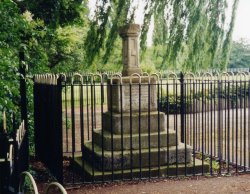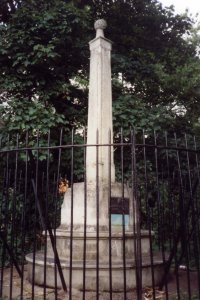

Until 1197, the Crown held all rights on the River Thames but in that year Richard I sold his rights to the Corporation of the City of London for £20,000 to raise funds for his Crusades. The Charter, which was not particularly clear, did not prescribe any limits for the jurisdiction but probably the whole River was intended. However, the Corporation of the City of London actually only carried out its duties as far East as Yantlet Creek (on the Isle of Grain) and as far West as Staines where it erected, in 1285, a stone (known as the London Stone) to mark the upper limit of its jurisdiction.
 |
Staines was chosen as it was the upper limit of the tidal reach before man-made locks and weirs were introduced and was also the first town upstream of London to have a bridge. Successive Lord Mayors travelled in ceremonial barges, rowed by Liveried Watermen, to touch the Stone with a sword to re-affirm the Corporationís rights to charge tolls on river traffic and levy taxes on structures such as fish traps. |
The London Stone |
Although Richard sold the Rights, it remained a royal prerogative to control all the River until 1350 when Edward III passed an Act of Parliament prohibiting the obstruction of the River, a fact that had been enshrined in Magna Carta in 1215. (See The River Thames - A Historical Perspective)
At this time there were numerous structures across the River which had been built by owners of the riverbed for fishing and milling purposes but these caused considerable problems for those wishing to navigate the River by boat.
To try and resolve these conflicting requirements, the responsibility for navigation above Staines, was entrusted to various commissions by a number of Acts of Parliament.
The first Commission (known as the Oxford-Burcot Commission) was appointed by James I, in an Act of 1605, to take responsibility for the Thames between Oxford and Burcot. This 1605 Act was a little vague so a new Act was introduced in 1624 which was more forceful: it gave the eight Commisioners full power to cleanse and make navigable the River between Oxford and Burcot including the right to open, prepare, or make all necessary weirs, locks and turnpikes. They also had the authority to make a towpath. In the 1630's, they constructed three pound locks, the first to be built on the River Thames: one at Iffley, one at Sandford and the third on the Swift Ditch at Abingdon.
This Commission was quite successful so in 1751, under Act 24 George II, the Thames Navigation Commissioners were appointed with similar powers to look after all the Thames above Staines. This was very unwieldy as membership of the Commission, which was up to 600 people, included every landowner in the Counties bordering the river and worth more than £100 plus representatives from Oxford University and the Mayors of all the River side towns. Furthermore, their powers were very limited.
In 1770 the Thames Act was enacted and the Commission was further expanded but, in spite of the large number of members, it only required a quorum of 11 Commissioners to conduct its business. This Act gave the Commission considerable powers including the right to acquire from Riparian Owners, by Compulsory Purchase, land for locks, weirs and the like. They built their first pound lock (Boulter's Lock) in 1772. This was followed by the building of a further seven locks between Sonning and Marlow in 1773.
Another Thames Act in 1795 gave the Commission more powers for the compulsory purchase of land for tow paths along the River but the powers did not include the right to acquire land where there was a house, garden or orchard close to the River. This limitation severely restricted the practical value of the Act.
The Commission divided the River into six districts:
1. London Bridge to Staines
2. Staines to Boulter's Lock
3. Boulter's Lock to Mapledurham
4. Mapledurham to Shillingford
5. Shillingford to Oxford
6. Oxford to Cricklade
Unfortunately by including District 1, which was in fact the responsibilty of the City of London, they caused quite a stir so, in 1771, the Commissioners themselves passed a resolution agreeing that they had no powers below the London Stone at Staines.
It took a further 40 years for the City of London to seek power to build a pound Lock, the first of which was at Teddington in 1811, nearly 180 years after the building of the first pound locks by the Oxford-Burcot Commission. Between 1812 and 1815 the City of London built a further five locks (Penton Hook, Chertsey, Shepperton, Sunbury and Molesey) within their jurisdiction.
With regard to the River below Staines, a dispute arose in 1840 (at the time the Victoria Embankment was first muted) between the Crown and the City of London as to the ownership of the bed and soil of the River Thames. The Crown advanced the the argument that as the Thames was a navigable river it was an arm of the sea and consequently there was a prima facia case that the bed and soil, as far as it ebbed and flowed, belonged to the Crown by virture of prerogative.
This dispute lasted for 17 years, but some 660 years after Richard II's Charter, the City of London finally agreed in December 1856, to withdraw all claims to the bed and soil of the River and admitted the claim of the Crown. In 1857 the Thames Conservancy Act was passed which created a new body, the Thames Conservancy, to control the Thames between Staines and Yantlet Creek. The Crown's land rights were re-conveyed to the Conservancy except in places immediately adjacent to a Royal Palace. The consideration was that one third of all future rents and fines were to be paid to the Crown with the balance used for the benefit of navigation.
The Thames Conservancy comprised a Board of 12 persons: the Lord Mayor, two aldermen, four nominees of the common council, the Deputy Master of Trinity House, two nominees of the Lord High Admiral, one nominee of the Privy Council and one by the Trinity House Deptford Strand.
In October 1857, the waterbailiff, his assistants and all the watermen of the Mayor of London were pensioned off and so ended the ancient right the City of London had enjoyed and exercised for the best part of 700 years.
Returning now to the River above Staines. By 1850 the financial position of the Commission became very serious; the building of the railways had taken its toll: trade from the barges was lost and the Commissioners faced bankruptcy with their loss of revenue. Consequently, in 1866 it was considered expedient to put the navigation of the whole of the River under one management so the Thames Conservancy (which was set up originally to control the River below Staines) was given the finance, responsibility and power to control the River from Yantlet Creek to Cricklade, a distance of 177 miles.
It was agreed at that time, that all the locks, canals and other works should be transferred to the Thames Conservancy and that the Commissioners would surrender their authority and the debt due to its bondholders would become liabilities of the Conservancy. It was also agreed that all property associated with any works be conveyed to the Conservancy who were to become responsible for the maintenance of the works. The former owners were relieved of their liabilities in respect of these works but they had 6 months to object to any transfer. Compensation was paid for all privately owned works so taken over. The Conservancy did not however, as a matter of course, acquire the soil or bed of the River above Staines. That remained with the riparian owners. They were however, given the power to compulsory purchase land that was required for further works.
 |
By the end of the nineteenth century, extensive works to both the docks and the River in London were required to cater for the larger ships then being used but the lack of a single authority prevented the necessary works from being carried out. Consequently, in 1900 a Royal Commission was appointed to inquire into the situation and in 1902 it produced a report recommending the creation of a new central authority. However, it was not until 1908 that the Port of London Act was passed. This Act transferred the powers of the Thames Conservancy below Teddington to a new body to be called the Port of London Authority (PLA) and it commenced its duties on 31 March 1909. The Act required the Port of London Authority to: |
"to take into consideration the state of the river and the accommodation and facilities afforded in the Port and, subject to the provisions of this Act, to take such steps as they may consider necessary for the improvement thereof"
The River above Teddington remained the responsibility of the Thames Conservancy.
And it is the Thames Conservancy that we have to thank for the current state of the River above Teddington and for the introduction of many of the facets of the River that we take for granted today. These include, amongst many other things, full-time lock-keepers, river patrols, well maintained locks, weirs and cottages, dredged channels, stabilised banks and public moorings. |
 |
 |
Following a report of the Central Advisory Water Committee in 1971, the Water Act 1973 was passed. This Act was far more compehensive than previous enactments dealing with water and river management. It abolished River Authorities, including the Thames Conservancy, statutory water boards and joint sewerage boards and transferred their functions to 10 new Regional Water Authorities. Consequently, on 1st April 1974 management of the River Thames above Teddington passed to Thames Water Authority (TWA) which reamained responsible until 1990. |
In 1990 the Government set up the National Rivers Authority (NRA) to manage all rivers in England and Wales and it was this Authority that took over from Thames Water. |
 |
 |
A further government reorganisation in 1996 resulted in the setting up of a national Environment Agency (EA) which took over, amongst other roles, the responsibilities of the NRA. It is the Thames Region of the EA that manages all navigational and recreational matters on the non-tidal Thames today. The EA is also responsible for all environmental matters relating the the whole of the River Thames. |
Although all of these later bodies had the right to acquire land for neccessary works, they never had the land over which the River flows, upstream of Staines, conveyed to them as a matter of right. They only had the right to control navigation, licence and approve the erection of any structure in or adjacent to the River, carry out maintenance and generally do any work to ensure the safety of the River and its users. Consequently, unless the Deeds or any plans attached thereto show otherwise, it is normally considered that Riparian Owners (owners of the land fronting the River), upstream of the London Stone, own up to the centre of the River.
Despite this, the owners cannot construct any structure in the river (such as a landing stage) without the consent of the EA and to whom they would have to pay an annual fee. The Environment Agency have produced a booklet entitled 'Living on the Edge - A Guide to the Rights and Responsibilities of a Riverside Owner' and can be obtained from any EA office or by calling them on 0118 953 5000.
Below the London Stone at Staines, and as mentioned above, the bed of the River was conveyed to the City of London by the Crown in 1857 and was then re-conveyed to the Thames Conservancy (except in places immediately adjacent to a Royal Palace) in the same year. So, below Staines the ownnership of the bed and soil of the River most likely belongs to the Successors in Title to the Thames Conservancy and not to the Riparian Owners, unless of course their Deeds show otherwise. The Successors in Title to the Thames Consevancy are the Environment Agency between Staines and Teddington and the Port of London Authority below Teddington.
As mentioned above, navigation on the Tidal Thames below Teddington is controlled by the Port of London Authority (PLA). The Boundary Stone, located beside the towpath just below Teddington Lock, marks the boundary between navigation responsibilities of the PLA and the EA. It was erected in 1909 when the PLA commenced its duties. |
 |
The Boundary Stone |
In 2001 the Government instigated a debate as to who should manage navigation on the Thames and sought views as to whether the Environment Agency (EA) should continue with its role or whether British Waterways (BW) should have its jurisdiction extended to include the River Thames as part of its inland waterways brief.
The EA, in its response, said that they were shortly to appoint a Waterways Manager (now appointed) for the whole of the Thames who would work closely with its newly appointed business development manager. They proposed to 'ringfence' money for the Thames and enter into an agreement with the Waterways Trust to raise extra money. They also said that its navigation role was an intrinsic part of its responsibility for managing and improving the water environment.
BW said that they would give the River Thames its own office and appoint a regional director to be resposible for the river. They would instigate a full repair programme and introduce a flexible licencing system. They believed that the EA should relinquish its navigation role and concentrate on its important regulatory function.
In its report on Inland Waterways dated 14 March 2001, the Environment Select Committee recommended that the EA should retain its Navigation responsibilities and on 21 November 2001, the Government concurred by announcing that navigation responsibilities for the River Thames would remain unchanged.
Over the last few years the River Thames has suffered from a lack of investment but during the winter of 2004/5, the Environment Agency spent £3.9 million on an extensive capital works programme. This was possible as the Department for Environment, Food and Rural Affairs (DEFRA), the EA's sponsoring body, injected an additional £2 million of funds. In May 2005, the EA announced that DEFRA had agreed a further £2 milion of cash for the year 2005/6 resulting in a £5 million capital works spend over the winter months involving 12 engineering projects.
To return to The River Thames page Click Here
Copyright © The Harts